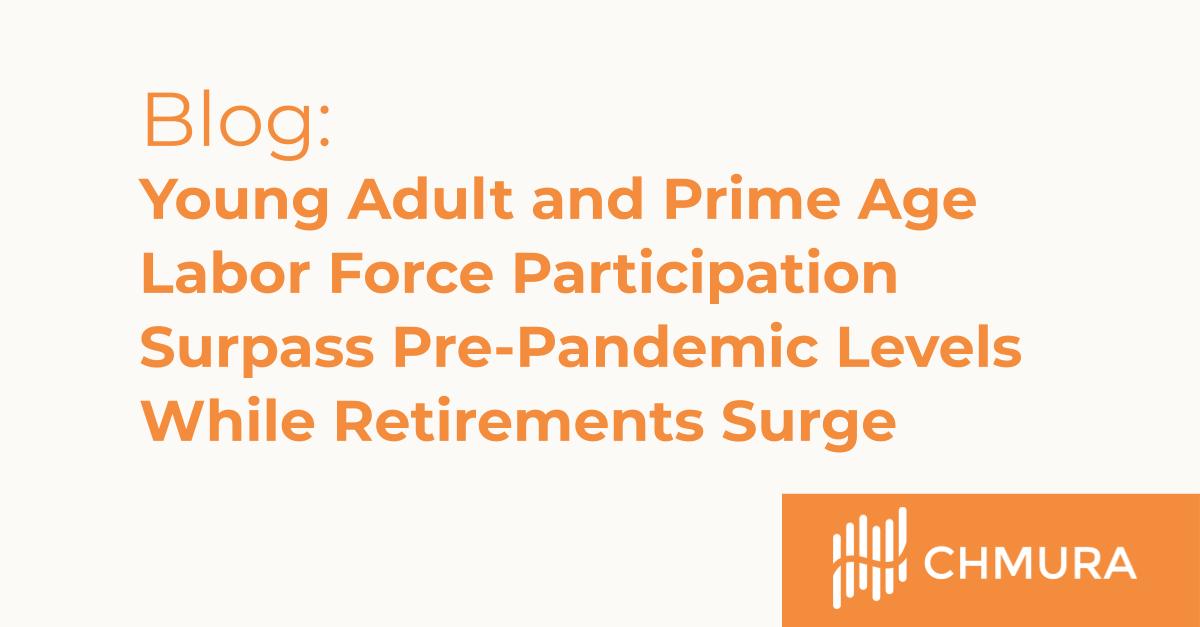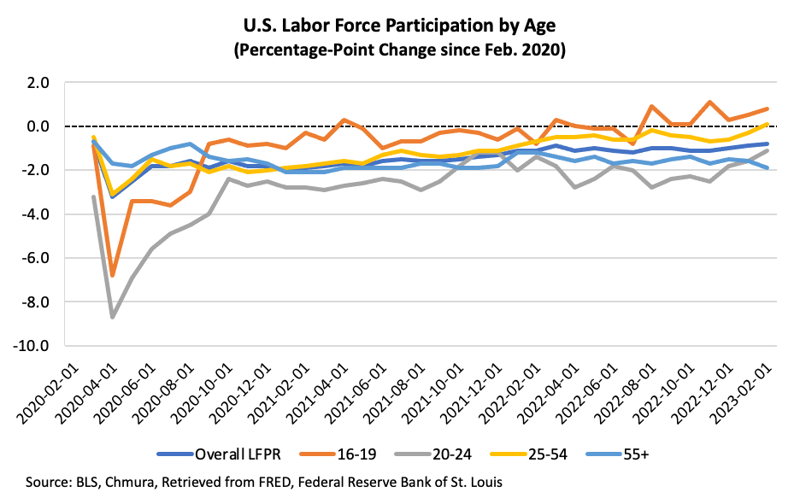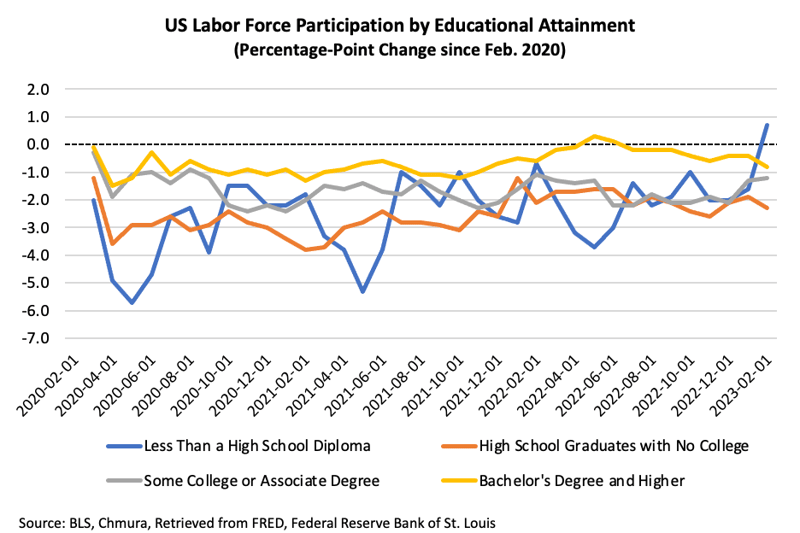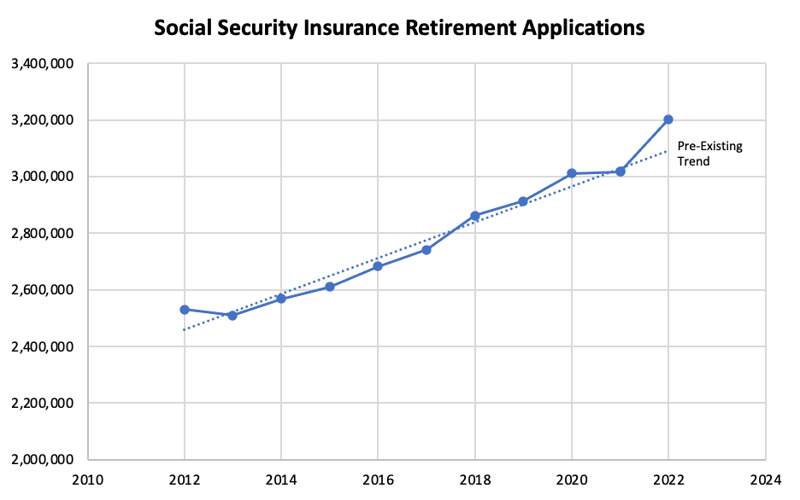Young Adult and Prime Age Labor Force Participation Surpass Pre-Pandemic Levels While Retirements Surge

As the Federal Reserve seeks to tame inflation, the labor shortage exacerbated by the pandemic continues to keep unemployment rates low and is likely slowing the deceleration in inflation. A key component of the labor shortage has been the fact that millions of workers dropped out of the labor force, but as of March 2023 there are nearly 2.3 million more people employed or unemployed than there were pre-pandemic in February 2020. Certain groups, however, have recovered faster than others.
The labor force participation rate (LFPR) measures the percentage of the civilian working-age population (16 years and older) that is either employed or actively seeking employment. LFPR in the nation has been declining since 2000 due to factors such as population aging; but since February 2020, the COVID-19 pandemic and response have caused a sharp drop in the LFPR. The seasonally adjusted pre-pandemic rate in February 2020 was 63.3% but fell to a low of 60.1% in April 2020. The initial recovery was swift as the LFPR rose to 61.5% by June 2020, but it has only reached 62.6% as of March 2023, or 0.7 percentage points below the pre-pandemic rate.
Within the overall participation rate, there is significant variation by age and educational attainment. The 25-54 age group is considered the prime employment age group, as it includes individuals who have typically completed their education and are still several years away from retirement. This group returned above pre-pandemic levels for the first time in February 2023.
The LFPR for individuals aged 16-19 is performing the best among the four age groups, with rates above pre-pandemic levels since August 2022. The LFPR for the 20-24 age group suffered the most severe dip during the pandemic recession but has also been trending upwards since August 2022. The rebounds in these two age groups could be because young people are finding more opportunities for employment as the economy recovers from the pandemic and some industries known for employing younger workers (such as service, retail, and construction) begin to offer more competitive starting wages.[1] In addition, the younger age groups have more opportunities in industries where older workers took early retirement or choose not to reenter the labor market due to fears of contracting Covid.

The return to the workforce for young workers is also apparent in the data for LFPR by educational attainment, particularly for non-high school graduates. As of 2021, 91.1% people age 25 and older in the U.S. had graduated high school[2] – indicating that the category of non-high school graduates is largely made up of younger workers still in high school. Individuals with less than a high school education experienced several ups and downs in LFPR since 2020, but this cohort is currently the only one above pre-pandemic levels, with a labor force participation rate of 37.6% in August 2022. As noted earlier, industries such as service, retail, and construction (which tend to have lower education requirements) are returning to pre-pandemic levels of employment and recent jobs reports[3] reveal that these industries continue to enjoy healthy growth even as others slow down. Many high school students may also be finally returning to seasonal and after-school jobs after the pandemic disrupted the market for many of the businesses that employed such students.[4]

The age group of 55 and above is performing the worst among the LFPR age cohorts, with rates down almost 2 percentage points from February 2020. A likely cause behind this trend is that older workers who delayed retirement during the pandemic are now retiring. Applications for Social Security Insurance Retirement stalled in 2021, which may have been due to the uncertainty of a COVID-19 economy and pandemic stimulus payments, but 2022 saw a surge of retirements, indicating that older workers who delayed retirement during the pandemic are no longer putting it off. However, recent reports have indicated many older workers are returning to the workforce[5] due to factors such as inflation, a need for more income, or even boredom – making the trends in this age group something to watch moving forward.

As older generations continue to leave the workforce, employers will be reliant on a younger demographic to fill open positions across the entire career ladder. Enacting policy that facilitates young adult workforce participation, developing and strengthening partnerships with high schools and colleges, designing flexible work arrangements that accommodate school schedules and other commitments, and providing adequate training and development for younger members of the workforce are all possible ways to continue the encouraging upward trend in young adult labor force participation and prepare for future tight labor market conditions.
-------------------------------------
[1] Source : https://www.cnbc.com/2022/06/16/teen-summer-workers-are-winning-higher-pay-and-more-flexibility-this-year.html
[2] Source : https://www.census.gov/newsroom/press-releases/2022/educational-attainment.html
[3] Source: https://www.bls.gov/news.release/empsit.nr0.htm
[4] Source : https://www.pewresearch.org/short-reads/2022/06/21/after-dropping-in-2020-teen-summer-employment-may-be-poised-to-continue-its-slow-comeback/
[5] Source: https://www.cnbc.com/2023/02/22/1-in-6-retirees-are-considering-a-return-to-the-workforce.html
Subscribe to the Weekly Economic Update
Subscribe to the Weekly Economic Update and get news delivered straight to your inbox.











